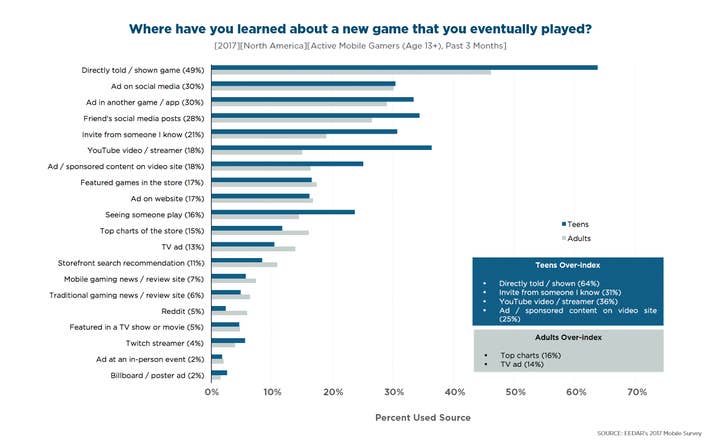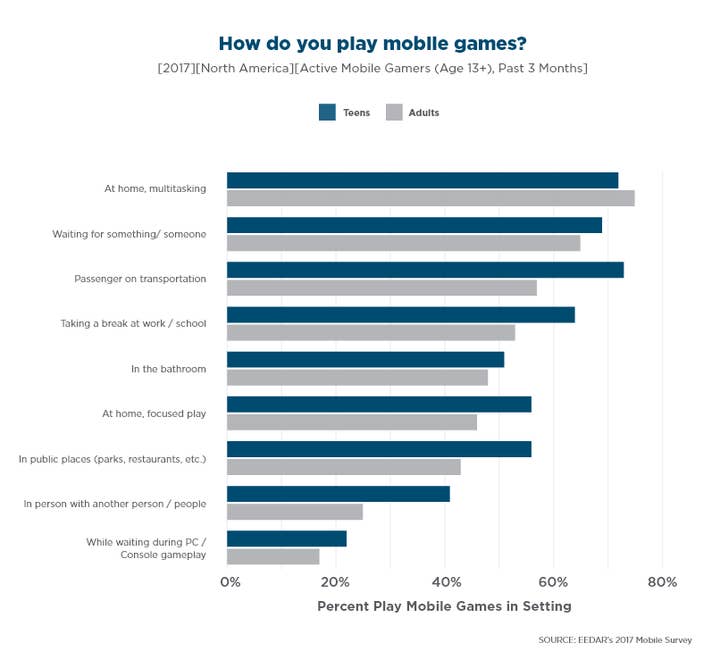Share, Stream, and Show - How today's teens interact with mobile games
EEDAR head of consumer research Heather Nofziger looks at how developers can appeal to the younger set without alienating older audiences
To say that teenagers are more social than adults in how they interact with mobile games is an understatement. But in order to understand why teenagers and adults interact with mobile games differently, you need to first look at how modern technology and social media factors in to their respective lives.
Today's adults are the generation that crafted the technology and social media platforms that today's teenagers take for granted. These modern marvels are a big part of the average adult's daily life, but many adults can also recall a time before their first 14.4 kilobaud modem connected to AOL (and their first online social experience). Today's teens, by contrast, literally have no frame of reference for a life without YouTube, smartphones, and constant connectivity.
When looking at their gaming habits, it should come as no surprise, then, that teenagers are twice as likely to start playing a new mobile game because they saw a streamer or influencer play it. What might be surprising, however, is that teens are also driving game virality through direct social channels - being significantly more likely to not only discuss the games they like with friends, but also to play them together in person.
This data comes from EEDAR's annual research on the North American mobile gaming market, which examines the habits, preferences and motivations of 3,000 active North American (US and Canada) adult mobile gamers and 1,000 active teen (13-17) mobile gamers to better understand the unique roles that both audiences play in the mobile gaming space. Understanding the differences in behavior and motivation between audiences is key to making sure your game fits within the expectations of the target market - whether teens or adults - and isn't asking them to alter how they play in order to engage with it.
How Teens Play
When drawing comparisons between adult and teen mobile gamers, one of the most apparent differences is the means by which they discover new games. Although social discovery channels (i.e. those that rely on players sharing with others) play a big role in discovery for most mobile gaming audiences, they are particularly key to driving teen interest - teens notably over-index in their discovery via direct word of mouth, friends' social media posts, direct invites from friends, and YouTube videos of gameplay (shared by streamers / influencers).

Adults, by contrast, over-index in their discovery of games through storefront channels - being more likely than teens to search for games within the app storefront, look at Top Charts or Featured Games/Apps. This data begins to suggest certain patterns in behaviors, where teenagers are more likely to emphasize titles that friends like or that are generating significant buzz (particularly on YouTube), and this trend toward deeper social engagement within the mobile space continues as we look at how and why teens play games, as well.
When addressing how teens play mobile games, we again see a trend towards social engagement. Teens notably over-index in their play of mobile games with and around other people - as a passenger on transportation (e.g. school buses), at school, in public spaces, and/or in person with other players.

Supporting play in these settings is teens' greater interest in shared social experiences within mobile games. When looking at the experiences that drive engagement with mobile games, teens notably over-index in their interest in competing with others, cooperating as a team and customizing/showing off their creations.
How to Talk to Teens
So what does all of this mean?
These trends highlight the importance of understanding the unique needs and interests of your game's target audience, and ensuring that the finished product is well tailored to meet those needs. In the case of teens, titles looking to achieve success should aim to be easy to share, stream, and show-off. They should make it easy for players to add and engage with friends, and, if possible, play together - whether in-person (Pokemon Go) or online (Roblox).
This is not to say that these factors should be the sole emphasis of the experience - as leaning too heavily on social gameplay can limit appeal to other audiences (adults and more casual gamers are likely to be less interested). Instead, these features should complement a strong core gameplay loop that is accessible to the greatest range of players.
For more information and a sample version of EEDAR's full 2017 Deconstructing Mobile & Tablet Gaming report, contact Cooper Waddell at cwaddell@eedar.com.